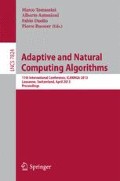Abstract
Artificial neural networks and symbolic expression based ensembles are used for solving classification problems. Ensemble members and the ensembling method are generated automatically with the self-configuring genetic programming algorithm that does not need preliminary adjusting. Performance of the approach is demonstrated with real world problems. The proposed approach demonstrates results competitive to known techniques.
Access this chapter
Tax calculation will be finalised at checkout
Purchases are for personal use only
Preview
Unable to display preview. Download preview PDF.
References
Bishop, C.: Pattern recognition and machine learning. Springer (2006)
Dietterich, T.G.: An experimental comparison of three methods for constructing ensembles of decision trees: bagging, boosting, and randomization. Machine Learning 40(2), 139–158 (2000)
De Stefano, C., Della Cioppa, A., Marcelli, A.: An evolutionary approach for dynamic configuration of multi-expert classification systems. In: Proceedings IEEE Congress on Evolutionary Computation, CEC 2006, pp. 2444–2450 (2006)
Kim, Y.W., Oh, I.S.: Classifier ensemble selection using hybrid genetic algorithms. Pattern Recognition Letters 29(6), 796–802 (2008)
Rokach, L.: Ensemble-based classifiers. Artificial Intelligence Review 33(1), 1–39 (2010)
Ho, T.K., Hull, J.J., Srihari, S.N.: Decision combination in multiple classifier systems. IEEE Transactions on Pattern Analysis and Machine Intelligence 16(1), 66–75 (1994)
Breiman, L.: Bagging predictors. Machine Learning 24(2), 123–140 (1996)
Friedman, J.H., Hastie, T., Tibshirani, R.: Additive logistic regression: a statistical view of boosting. Annals of Statistics 28(2), 337–374 (2000)
Navone, H.D., Granitto, P.M., Verdes, P.F., Ceccatto, H.A.: A learning algorithm for neural network ensembles. Inteligencia Artificial, RevistaIberoamericana de Inteligencia Artificial (12), 70–74 (2001)
Johansson, U., Lofstrom, T., Konig, R., Niklasson, L.: Building Neural Network Ensembles using Genetic Programming. In: International Joint Conference on Neural Networks (2006)
Poli R., Langdon W.B., McPhee N.F.: A Field Guide to Genetic Programming (2008), Published via, http://lulu.com and freely available, http://www.gp-field-guide.org.uk
Bukhtoyarov, V., Semenkina, O.: Comprehensive evolutionary approach for neural network ensemble automatic design. In: Proceedings of the IEEE World Congress on Computational Intelligence, pp. 1640–1645 (2010)
Semenkin, E., Semenkina, M.: Self-Configuring Genetic Programming Algorithm with Modified Uniform Crossover. In: Liu, J., et al (eds.): CEC IEEE WCCI 2012, Congress on Evolutionary Computations of IEEE World Congress on Computational Intelligence, Brisbane, Australia, pp. 1918–1923 (2012)
Gomez, J.: Self Adaptation of Operator Rates in Evolutionary Algorithms. In: Deb, K., Tari, Z. (eds.) GECCO 2004. LNCS, vol. 3102, pp. 1162–1173. Springer, Heidelberg (2004)
Meyer-Nieberg, S., Beyer, H.-G.: Self-Adaptation in Evolutionary Algorithms. In: Lobo, F., Lima, C., Michalewicz, Z. (eds.) Parameter Setting in Evolutionary Algorithm, pp. 47–75 (2007)
Angeline, P.J.: Two Self-Adaptive Crossover Operators for Genetic Programming. In: Angeline, P.J., Kinnear Jr., K.E. (eds.) Advances in Genetic Programming, vol. 2, pp. 89–110 (1996)
Finck, S., et al.: Real-parameter black-box optimization benchmarking 2009. In: Presentation of the noiseless functions. Technical Report ResearhCenter PPE (2009)
Semenkin, E., Semenkina, M.: Self-configuring Genetic Algorithm with Modified Uniform Crossover Operator. In: Tan, Y., Shi, Y., Ji, Z. (eds.) ICSI 2012, Part I. LNCS, vol. 7331, pp. 414–421. Springer, Heidelberg (2012)
Frank, A., Asuncion, A.: UCI Machine Learning Repository. University of California, School of Information and Computer Science, Irvine, CA (2010), http://archive.ics.uci.edu/ml
Yu, J.J.Q., Lam, A.Y.S., Li, V.O.K.: Evolutionary Artificial Neural Network Based on Chemical Reaction Optimization. In: IEEE Congress on Evolutionary Computation (CEC 2011), New Orleans, LA (2011)
Semenkin, E.S., Semenkina, M.E.: Artificial neural networks design with self-configuring genetic programming algorithm. In: Filipic, B., Silc, J. (eds.) Bioinspired Optimization Methods and their Applications: Proceedings of the Fifth International Conference, BIOMA 2012, pp. 291–300. Jozef Stefan Institute, Ljubljana (2012)
Huang, J.-J., Tzeng, G.-H., Ong, C.-S.: Two-stage genetic programming (2SGP) for the credit scoring model. Applied Mathematics and Computation 174, 1039–1053 (2006)
Sergienko, R., Semenkin, E., Bukhtoyarov, V.: Michigan and Pittsburgh Methods Combining for Fuzzy Classifier Generating with Coevolutionary Algorithm for Strategy Adaptation. In: 2011 IEEE Congress on Evolutionary Computation, New Orleans, LA (2011)
Stolfo, S., Fan, W., Lee, W., Prodromidis, A., Chan, P.: Cost-based Modeling for Fraud and Intrusion Detection: Results from the JAM Project. In: Proceedings of the 2000 DARPA In-formation Survivability Conference and Exposition, DISCEX 2000 (2000)
Malik, A.J., Shahzad, W., Khan, F.A.: Binary PSO and random forests algorithm for PROBE attacks detection in a network. In: IEEE Congress on Evolutionary Computation, pp. 662–668 (2011)
Author information
Authors and Affiliations
Editor information
Editors and Affiliations
Rights and permissions
Copyright information
© 2013 Springer-Verlag Berlin Heidelberg
About this paper
Cite this paper
Semenkina, M., Semenkin, E. (2013). Classifier Ensembles Integration with Self-configuring Genetic Programming Algorithm. In: Tomassini, M., Antonioni, A., Daolio, F., Buesser, P. (eds) Adaptive and Natural Computing Algorithms. ICANNGA 2013. Lecture Notes in Computer Science, vol 7824. Springer, Berlin, Heidelberg. https://doi.org/10.1007/978-3-642-37213-1_7
Download citation
DOI: https://doi.org/10.1007/978-3-642-37213-1_7
Publisher Name: Springer, Berlin, Heidelberg
Print ISBN: 978-3-642-37212-4
Online ISBN: 978-3-642-37213-1
eBook Packages: Computer ScienceComputer Science (R0)

